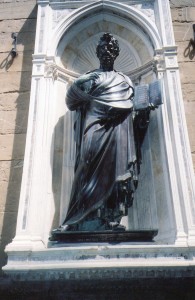Florence in the Renaissance influenced Western culture as much as Athens, Rome, Paris and London did. 3 dimensional perspective was theorized there. And no building had more impact on Florence than Orsanmichele.
Sculptures, like Lorenzo Ghiberti’s St. Matthew (above), helped usher in perspectives that we take for granted today. We’ll examine it and compare it with another culture to see more of its beauty.
Ghiberti sculpted St. Matthew in 1419-22. He had learned from Donatello’s St. Mark, which resembles an individual man with a massive body more than Ghiberti’s earlier statue of St. John the Baptist does. But Ghiberti now took this realism farther.
St. Matthew engages you more intensely. His gospel is open, and he’s gesturing to it. He has a message that he wants to give you, and he assumes the position of a Roman orator to dramatize the importance of Jesus’ life. Donatello’s St. Mark looks into the distance. But St. Matthew more specifically brings you into his space. He’s more animated, and he points to a real text.
St. Matthew begins to embody and animate a 3 dimensional space before Alberti wrote a mathematical theory of 3 dimensions, and before painters mastered it. By looking at you, and by gesturing towards a book, St. Matthew concentrates the focus on two points–he’s not contemplating the universe and gazing into space. Ghiberti carved St. Matthew for the bankers’ guild, and this view of a person involved in the world must have appealed to its members.
The above masterpiece, The Doubting Of Thomas, was made later (1467-83), by Andrea del Verrocchio. Alberti had written his mathematical theory, and painters had employed it. So Verrocchio expresses this space more fully. Jesus shows Thomas his wound. So like St. Matthew, Jesus addresses a person and shows him something specific. But the relationship is more human. Jesus isn’t in the position of an ancient orator. He’s a gentle and caring young man. The relationship between two people is now characterized by love. St. Matthew teaches the word. In Jesus, the word not only becomes flesh–it becomes love. Verrocchio’s opus almost makes you feel his soft heart.
The above Buddha statue graces a town in northern Thailand called Nan. It mixes features of 2 styles of sculpture that northern Thais developed while Florentine artists were theorizing and fleshing out 3 dimensional perspective.
The Sukhothai style shows up as the small hair curls and the delicate facial lines–it softens forms into a graceful flow. The Phra Singh style is more masculine–it can be seen in the statue’s broad chest and arms. Grace and strength are perfectly balanced as Sakyamuni is about to achieve enlightenment.
But there’s no intense and personal engagement between two individuals. The space isn’t a small 3 dimensional area in which people are examining details of things and expressing feelings to each other. It’s more cosmic and general. It extends from the Buddha and radiates its graceful forms throughout the hall, where people kneel down and bow 3 times, hoping for good fortune.
Thai’s beautify this space beyond belief. But Western art has special characteristics, which sculpture that Florentines commissioned on Orsanmichele pioneered.
1. Three dimensional space in which people engage each other.
2. People pointing to specific things.
3. Folks emotionally involved with each other.
This way of representing reality converged from many currents. It’s rooted in the ancient Greek world. But Florentines added ways for people to relate to each other, and to concentrate on small spaces in which folks interacted within a world that was realistically portrayed. The word first became muscle, and then love. Florentines made this love human.






Comments on this entry are closed.